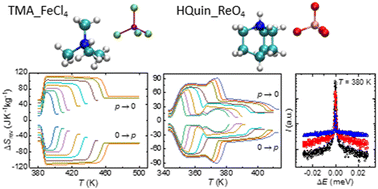Large barocaloric effects in two novel ferroelectric molecular plastic crystals†
Abstract
Materials undergoing pressure-driven solid–solid phase transformations can be a valuable alternative for eco-friendly refrigeration, heat pumping and waste heat recovery based on the barocaloric effect. Ferroelectric compounds and plastic crystals have shown their potential in these fields because they may undergo large changes in volume and entropy at the transition, which underpin a large pressure-induced caloric response. Recently, a new class of materials combining a high-temperature plastic phase with a low-temperature ferroelectric phase has been reported. Here we investigate the barocaloric properties of two such “ferroelectric plastic crystals”, namely quinuclidinium perrhenate (C7H14NReO4) and tetramethylammonium tetrachloroferrate (N(CH3)4[FeCl4]). The reversible adiabatic temperature changes under pressure of around 100 MPa (8 K for C7H14NReO4 and 21 K for N(CH3)4[FeCl4]) reach values comparable to other plastic crystals and other materials, which demonstrates a good prospect for this novel barocaloric materials family. The dynamics of the plastic phase for C7H14NReO4 has been investigated by means of quasielastic neutron scattering.



 Please wait while we load your content...
Please wait while we load your content...